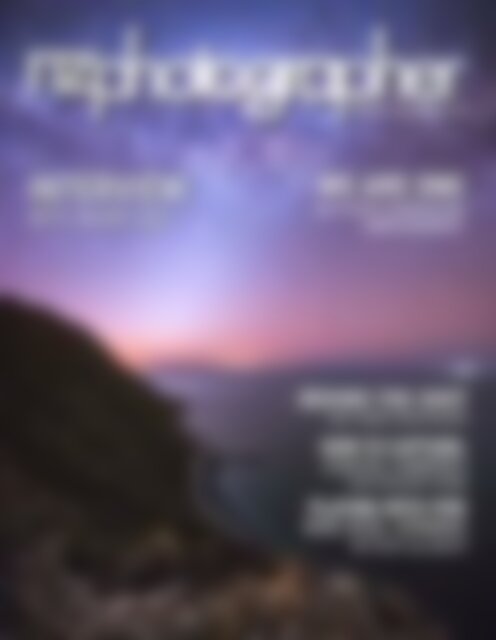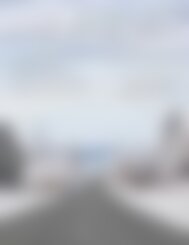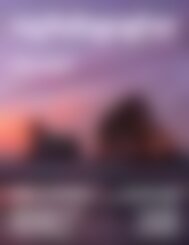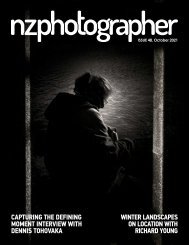NZPhotographer Issue 11, Sept 2018
As of December 2022, NZPhotographer magazine is only available when you purchase an annual or monthly subscription via the NZP website. Find out more: www.nzphotographer.nz
As of December 2022, NZPhotographer magazine is only available when you purchase an annual or monthly subscription via the NZP website. Find out more: www.nzphotographer.nz
You also want an ePaper? Increase the reach of your titles
YUMPU automatically turns print PDFs into web optimized ePapers that Google loves.
ISSUE <strong>11</strong>, <strong>Sept</strong>ember <strong>2018</strong><br />
INTERVIEW<br />
WITH MARK GEE<br />
WE ARE ONE<br />
NZP PHOTO COMPETITION<br />
ANNOUNCEMENT<br />
BEHIND THE SHOT<br />
WITH MIKE MACKINVEN<br />
HOW TO CAPTURE:<br />
COASTAL SUNRISES<br />
WITH RICHARD YOUNG<br />
PLAYING WITH FIRE<br />
WIRE WOOL SPINNING<br />
WITH RAY SALISBURY<br />
<strong>Sept</strong>ember <strong>2018</strong><br />
1
WELCOME TO ISSUE <strong>11</strong> OF<br />
NZ PHOTOGRAPHER MAGAZINE<br />
HELLO EVERYONE,<br />
You'll be seeing starts in this<br />
issue as we look up at the<br />
night sky for inspiration!<br />
We have interviewed worldrenowned<br />
photographer<br />
Mark Gee, he of Full Moon<br />
Silhouette fame. Local legend<br />
Ray Salisbury has been playing<br />
with fire and walks us through<br />
wire wool spinning step-bystep,<br />
and then, in Behind<br />
The Shot we head back to<br />
that famous NZ location to<br />
learn how Mike of Mack<br />
Photography captured the<br />
Milky Way over the Wanaka<br />
Tree. Leaving the stars behind<br />
and looking out to sea,<br />
Richard reminds us to always look behind when shooting coastal<br />
sunrises and sunsets and Brendon Gilchrist recounts his shipwreck<br />
adventure.<br />
This issue is also full of opportunity for you to get involved and win<br />
some outstanding prizes... We have teamed up with Wellington<br />
Botanical Garden as they celebrate 150 years with an exciting<br />
competition that runs for a year. Plus, NZP celebrates its 1 year<br />
relaunch next month and to celebrate, we're running a special<br />
competition that covers 4 categories with 4 prizes to be won, judged<br />
by local and international judges. Turn to page 35 to meet the<br />
judges and learn all about it.<br />
Emily Goodwin<br />
Editor NZ Photographer<br />
REGULAR CONTRIBUTORS<br />
Brendon Gilchrist<br />
Brendon is the man behind ESB<br />
Photography. He treks from sea to<br />
mountain, and back again, capturing<br />
the uniqueness of New Zealand’s<br />
unforgiving landscape.<br />
Richard Young<br />
Richard is an award-winning<br />
landscape and wildlife photographer<br />
who teaches photography workshops<br />
and runs photography tours. He is the<br />
founder of New Zealand Photography<br />
Workshops.<br />
General Info:<br />
<strong>NZPhotographer</strong> <strong>Issue</strong> <strong>11</strong><br />
<strong>Sept</strong>ember <strong>2018</strong><br />
Cover Photo<br />
by Mark Gee<br />
www.theartofnight.com<br />
Night On The Ridge<br />
Publisher:<br />
Excio Group<br />
Website:<br />
www.excio.io/nzphotographer<br />
Group Director:<br />
Ana Lyubich<br />
ana@excio.io<br />
Editor:<br />
Emily Goodwin<br />
Graphic Design:<br />
Maksim Topyrkin<br />
Advertising Enquiries:<br />
Phone 04 889 29 25<br />
or Email hello@excio.io<br />
nzphotographer nzp_magazine nzp@excio.io<br />
© <strong>2018</strong> <strong>NZPhotographer</strong> Magazine<br />
All rights reserved. Reproduction of any material appearing in this magazine in<br />
any form is forbidden without prior consent of the publisher.<br />
Disclaimer:<br />
Opinions of contributing authors do not necessarily reflect the<br />
opinion of the magazine.<br />
2 <strong>NZPhotographer</strong> <strong>Sept</strong>ember <strong>2018</strong> 3
CONTENTS<br />
6<br />
INTERVIEW<br />
WITH MARK GEE<br />
17<br />
6<br />
16<br />
INTERVIEW WITH MARK GEE<br />
OF THE ART OF NIGHT<br />
HOW TO CAPTURE: COASTAL SUNRISES & SUNSETS<br />
with Richard Young<br />
17 SHIPWRECKED<br />
by Brendon Gilchrist<br />
20<br />
22<br />
30<br />
34<br />
37<br />
WELLINGTON BOTANICAL<br />
GARDEN COMPETITION<br />
PLAYING WITH FIRE<br />
WIRE WOOL SPINNING TUTORIAL<br />
by Ray Salisbury<br />
BEHIND THE SHOT<br />
with Mike MacKinven<br />
WE ARE ONE COMPETITION<br />
BEST READERS' SUBMISSIONS<br />
THIS MONTH<br />
22<br />
SHIPWRECKED<br />
THE DIFFERENCE MAKER<br />
16<br />
MARK<br />
100 SENSOR<br />
HOW TO CAPTURE: COASTAL<br />
SUNRISES AND SUNSETS<br />
Playing with Fire<br />
WIRE WOOL SPINNING<br />
TUTORIAL<br />
The search for uncompromising photography and videography performance is over. The<br />
Nikon D850 sets remarkable standards of quality with an impressive 45.7 effective megapixels.<br />
Capture the most awe-inspiring images and produce phenomenal 8K UHD time-lapse movies.<br />
Create epic film masterpieces in full-frame 4K UHD with NIKKOR wide-angle lenses, or prolong<br />
exquisite moments with its 120p/100p Full HD slow-motion recording.<br />
Purchase from an Authorised Nikon New Zealand Retailer to receive an Extended Two Year Local Warranty.<br />
www.Nikon.co.nz<br />
<strong>Sept</strong>ember <strong>2018</strong><br />
5
Interview with<br />
Mark Gee of<br />
The Art of Night<br />
CAMPING UNDER THE STARS<br />
F2.8, 30s, ISO3200<br />
HI MARK, WOULD YOU CARE TO INTRODUCE<br />
YOURSELF TO OUR READERS?<br />
I’m Mark Gee (Gee pronounced as the letter G) and these<br />
days I class myself as a photographer and filmmaker.<br />
I’m currently based in Wellington, but New Zealand<br />
isn’t my country of origin. I was born and grew up<br />
on the east coast of Australia. I found my love of<br />
photography aged about 14. My uncle dabbled in<br />
photography and took me to an auction to buy my<br />
first camera, which was a Canon film camera. I did<br />
photography as a subject at school and even had my<br />
own darkroom set up at home.<br />
After leaving school, I studied graphic design and<br />
worked at various places, from an architectural office<br />
to a magazine publisher and even a signwriting shop.<br />
I became interested in 3D animation and set my sights<br />
on a career in the film and television industry. I landed<br />
my first job in the industry working on a television series<br />
and also TV commercials and within a few years, I got<br />
the opportunity to come to New Zealand to work on<br />
Lord of the Rings at Weta Digital.<br />
This was certainly the start of something special, and<br />
15 years on, New Zealand is now home. Coming to<br />
New Zealand inspired me to explore my photography<br />
more, which now is a big part of my life.<br />
6 <strong>NZPhotographer</strong><br />
I run a few workshops throughout the year. They range<br />
from The Art of Night Wellington meet up which around<br />
1000 people attended last year, to multi-day workshops<br />
for up to 10 people. I also do workshops overseas<br />
including the now legendary PhotoPills Camp on the<br />
island of Menorca in Spain. Most of the workshops focus<br />
on astrophotography, but I also do some workshops<br />
with other photographers which are multi-disciplined.<br />
HOW DID YOU GET INTO<br />
ASTROPHOTOGRAPHY SPECIFICALLY?<br />
It wasn’t until I came to Wellington in 2003 and went<br />
and visited Castlepoint for the first time. It was one of<br />
those perfectly crisp and clear winter nights, I went<br />
outside to put the rubbish out and looked up. I had<br />
never seen so many stars in my life, and it was the first<br />
time I had ever seen the Milky Way with my own eyes.<br />
I ran back inside, grabbed my camera and tripod,<br />
and with no real knowledge of how to take a photo<br />
of the night sky, I pointed the camera up and took<br />
a shot. The photo itself was really disappointing, as<br />
I could see more stars with my own eyes than what<br />
was in the photo itself! But that was the night when my<br />
passion for astrophotography was ignited and things<br />
have only improved from there!<br />
GALACTIC FLOW<br />
F4, 30s, ISO6400
VALLEY OF STARS<br />
F2.8, 30s, ISO6400
HEAVENS ABOVE PALLISER<br />
F2.8, 30s, ISO6400<br />
YOU’VE WON TOO MANY PHOTOGRAPHY<br />
AWARDS AND COMPETITIONS FOR US TO<br />
NAME… WHICH HAS BEEN YOUR PROUDEST<br />
ACHIEVEMENT?<br />
My proudest achievement would have to be<br />
Astronomy Photographer of the Year in 2013. Not<br />
only did I win the People and Space and the Earth<br />
and Space categories, but I also won the Astronomy<br />
Photographer of the Year overall. And within the<br />
10 year history of the awards, that has never been<br />
done again. I never expected anything like that, so<br />
you can imagine my excitement when I did find out<br />
I had won! My only regret was I didn’t go to London<br />
for the awards, but I was well represented there by<br />
my sister.<br />
WHAT EQUIPMENT ARE YOU SHOOTING<br />
WITH?<br />
I’ve just recently switched from Canon to Nikon and<br />
am really loving the new gear. I’m currently shooting<br />
with a Nikon D850 and my favorite astro lens is the<br />
Nikon 14-24mm f/2.8<br />
TELL US MORE ABOUT YOUR CAREER IN THE<br />
FILM INDUSTRY…<br />
I’ve been working in the visual effects side of the film<br />
industry for over 20 years now, and for 15 of those<br />
years, I’ve been at Weta Digital in Wellington. My<br />
current role is a Visual Effects Supervisor, so I work<br />
with the artists and other supervisors to deliver the<br />
director’s vision for the film. It can be demanding<br />
work, but also very rewarding once you get to see<br />
the final product on the big screen.<br />
WHERE’S YOUR FAVOURITE SPOT IN NZ?<br />
I’ve got a few favourite spots, especially on the<br />
South Island where the skies are dark and the<br />
landscape spectacular. But I would have to say<br />
the one place for me would have to be Cape<br />
Palliser in the Wairarapa. It is the first real dark sky<br />
location I shot at, and I love going there and finding<br />
new interesting compositions. The Cape Palliser<br />
Lighthouse is always great to shoot against the night<br />
sky too.<br />
GUIDING LIGHT TO THE STARS<br />
F4, 30s, ISO6400<br />
UNIVERSAL SCALE<br />
F4, 30s, ISO6400
WANUI NIGHTS<br />
F2.8, 25s, ISO6400
UNIVERSAL BONDING<br />
F3.2, 30s, ISO3200<br />
WHAT TIPS CAN YOU SHARE WITH OUR<br />
READERS FOR SHOOTING ASTRO?<br />
Always plan your astrophotography shots well<br />
in advance and do the location scouting in the<br />
daytime. Use planning apps so you know exactly<br />
where the Milky Way will be in the sky at the planned<br />
location - I personally use an app called Photopills<br />
which is like the swiss army knife of astrophotography<br />
planning.<br />
When you do get to your location at night, make sure<br />
you allow yourself plenty of time to set up and frame<br />
the shot. I usually arrive at least an hour before I plan<br />
to start shooting.<br />
Focusing is one of the hardest things to get right in<br />
astrophotography. I use the live view function on my<br />
camera and then find the brightest star in the night<br />
sky and try to get it towards the centre of your LCD<br />
screen. Once you’ve done that, make sure you are in<br />
manual focus. Magnify your live view screen as large<br />
as it goes (usually 10x) and rotate your focus ring until<br />
the star looks sharp. Take a photo and then zoom in<br />
on the image to check the sharpness. Hopefully your<br />
stars will be in focus and you are now good to go.<br />
WHAT’S NEXT FOR YOU?<br />
I’m starting to work on a few personal projects which<br />
I’ve been wanting to do for a long time, so I’m<br />
cutting down on the workshops, public speaking and<br />
travelling so I can get back to doing my own thing. I<br />
enjoy doing all of those other things but want to get<br />
back to where it all started for me, and just go out<br />
and shoot for myself for the time being.<br />
WHERE CAN WE FIND YOU ONLINE?<br />
www.instagram.com/theartofnight<br />
www.facebook.com/theartofnight<br />
www.theartofnight.com<br />
DO YOU HAVE A SINGLE FAVOURITE IMAGE?<br />
My favourite changes all the time, but my all time<br />
sentimental favorite would be the one I shot of my son<br />
and I looking up at the Milky Way in Kaikoura three<br />
years ago. I called the image Universal Bonding. It was<br />
taken on the last night of a week long road trip my<br />
son and I did on the South Island – We try to go on an<br />
annual road trip each year to explore new locations<br />
and photo opportunities. I’d been trying for over a<br />
year to get him to pose and stand still with me long<br />
enough for the 30 second exposure, and on this night<br />
he finally did. It was the perfect moment for the end<br />
of an amazing trip.<br />
TELL US ABOUT THE FAMOUS FULL MOON<br />
SILHOUETTES...<br />
I always like to try and come up with fresh ideas and<br />
the Full Moon Silhouettes (which you can see here)<br />
was one of those. It took me a year to capture the<br />
moonrise as I had envisaged it, but it was all worth the<br />
many frustrating failed attempts.<br />
14 <strong>NZPhotographer</strong><br />
The night I finally pulled it off was a perfect evening<br />
with not one breath of wind, which doesn’t happen<br />
often in Wellington! I was in a park 2.1km away from<br />
the people on the Mount Victoria Lookout and I didn’t<br />
know if I had lined up the shot correctly, but as I hit the<br />
record button on my camera and the moon began<br />
to rise, everything fell into place better than I ever<br />
expected.<br />
At that point, I knew I had captured something cool,<br />
but I had no idea of the impact it would eventually<br />
have on people... until it went viral. That was totally<br />
unexpected and quite overwhelming, I was getting<br />
hundreds of emails a day from people all over the<br />
world sharing their experience of watching the<br />
moonrise as well as media interview requests and<br />
even academics offering their expert opinions.<br />
That video gave me lots of opportunities - It got my<br />
name out there and my astrophotography noticed.<br />
I had the opportunity to travel and run workshops<br />
around the world, as well as doing various media and<br />
public speaking engagements, and of course, my<br />
TedX talk which was an amazing experience on its<br />
own!<br />
MOON SILHOUETTES<br />
F9, 1/125s, ISO400<br />
<strong>Sept</strong>ember <strong>2018</strong><br />
15
HOW TO CAPTURE: COASTAL SUNRISES AND SUNSETS<br />
Coastal photography tips with Richard Young<br />
SHIPWRECKED<br />
by Brendon Gilchrist<br />
Sunrise, Abel Tasman National Park<br />
FIND A SUBJECT:<br />
Coastal shots are often largely made up of sky<br />
and water, but they also need a focal point to<br />
help draw in the eye of the viewer. This could be<br />
some foreground detail like a rock in the sea or a<br />
landscape feature such as a distant headland. Make<br />
sure the subject fills your shot so you don’t leave the<br />
viewer lost and looking around for it.<br />
LOOK AROUND YOU:<br />
As the sun slips over the horizon, it casts a beautiful<br />
golden light across the beach. Whilst everyone else<br />
is busy looking at the sun and shooting that scene,<br />
take a moment to look around, the scene behind you<br />
might be gorgeous too.<br />
CAPTURE THE WAVES:<br />
Waves present a great opportunity to add a creative<br />
element. Experiment with different shutter speeds to<br />
either freeze or capture the movement of the waves.<br />
To freeze the waves and capture them as they break,<br />
use a fast shutter speed, ideally faster than 1/500sec.<br />
To blur the waves and capture their movement, use<br />
an exposure of 1 second or longer.<br />
ADD SOME SKY:<br />
F8, 30s, ISO 100, 24mm<br />
One advantage of being on the beach at sunset or<br />
sunrise is that the horizon out to sea gives you a lot of<br />
sky. If you have interesting clouds, use a wide-angle<br />
lens and place your horizon lower in the photograph<br />
to capture more of the sky.<br />
CAPTURE SOME OF THE COUNTRY'S BEST COASTAL LANDSCAPES ON A 4-DAY GOLDEN BAY PHOTO<br />
TOUR: 27TH - 30TH SEPTEMBER WITH NEW ZEALAND PHOTOGRAPHY WORKSHOPS<br />
I<br />
always felt like I wanted to shoot a shipwreck.<br />
But with no shipwrecks nearby I pushed it to the<br />
back of my mind. A few months later one of<br />
the world’s oldest schooner’s beached itself not far<br />
from Christchurch.<br />
It is hard to describe what I felt when I was scrolling<br />
through my Facebook feed and saw that the MV<br />
Tuhoe had beached itself near the head of the<br />
Waimakariri River. I could not believe that it had<br />
happened!<br />
This 97 foot double masted auxiliary schooner,<br />
constructed of triple skin kauri, was built in<br />
Auckland in 1919 by George Nicol. Her Maori name<br />
meaning ‘the children of the mist’.<br />
I saw this as an opportunity not just for<br />
photography, but to document the resting place of<br />
a piece of history but I only had 1 night in which to<br />
do it.<br />
After a day of work followed by a basketball<br />
commitment at night, I drove to the nearest car<br />
park and walked the 40 min along the beach in the<br />
dark. It felt like forever, as if the beach would never<br />
end. Was I walking through portals and coming<br />
back to the same piece of driftwood? Maybe I<br />
was? Off in the distance, I could see a shape but<br />
it was still far away. I keep walking, enjoying the<br />
sound of the crashing waves, hoping I would not<br />
step on a sleeping seal.<br />
The further I walked the more the shape resembled<br />
a boat – I felt a sense of relief, I was nearly there. It<br />
was around 10.30pm by this time and I didn’t know<br />
when the moon was going to rise and also had<br />
no idea that it was a full moon at this point – Not<br />
conditions I would have chosen to shoot in if given<br />
a different option.<br />
As I continued walking I could see the glow getting<br />
stronger on the horizon and thought “oh no, you<br />
got to be kidding. I have only a few minutes before<br />
the moon rises.” If you have never sat and watched<br />
the moon rise you won’t realise how fast it moves. I<br />
quickly put my camera bag down, looked at what I<br />
had to work with and got my camera out and onto<br />
the tripod as fast as possible. It’s these moments<br />
when you need be creative in an instance – I<br />
needed to capture the emotions of this boat as fast<br />
as possible.<br />
I managed to get 3 great compositions before the<br />
moon got too high and bright. The reflections in<br />
the sand and the moon rising to the side, this its last<br />
night alive... I was privileged to stand there alone,<br />
shivering cold, capturing the moment.<br />
I set up my time lapse after I had taken the stills<br />
and stepped aside to let the camera do all the<br />
work. Over the next hour and a half, I watched the<br />
moon rising and the stars rotating. These moments<br />
of waiting, of being cold, of being entirely alone,<br />
are also some of the most inspiring. I was witnessing<br />
the last night that this boat got to see on this earth,<br />
<strong>Sept</strong>ember <strong>2018</strong><br />
17
sailing no more, just resting upon the land where<br />
it was once built. Being alone and in awe in these<br />
times is challenging but rewarding, the solitude is<br />
great but company, someone to share the moment<br />
with, is better. I believe everything has beauty even<br />
if many do not see it. If you look past the tragedy<br />
that has happened you will see something new. It<br />
may even help you as a photographer to capture<br />
something that has an ending and will never be<br />
seen again.<br />
After my time lapse had finished I took a quick selfie<br />
beside the boat then, after packing up, struggling<br />
to put my gear in my bag as I was shivering so<br />
much, I headed off into the darkness, back along<br />
the beach on the 4km walk back to the carpark. It<br />
was well after midnight and I had work at 7am but<br />
my thoughts were this; I have photos that no one<br />
else has. I have captured something I wanted to<br />
shoot. I enjoyed my day. There is not much more I<br />
could have asked for.<br />
The next day I saw photos of The Tuhoe being<br />
pulled apart with a digger. There was nothing that<br />
could be done to save the boat as it was too far<br />
up the beach and there was no way to pull it back<br />
into the ocean, the stern having twisted from every<br />
wave and tidal change but it was so sad to see<br />
something so rich in history being destroyed.<br />
3 TIPS FOR SHOOTING A TRAGEDY<br />
• Respect the moment for what it is.<br />
• If you know the history of the subject you are<br />
shooting, this will help you to capture the emotions.<br />
• Don’t question ‘should I go out with the camera?’<br />
Do it as soon as you can because time is of the<br />
essense – The opportunity could be gone before<br />
you know it.<br />
18 <strong>NZPhotographer</strong> <strong>Sept</strong>ember <strong>2018</strong> 19
Celebrating 150 Years of<br />
Wellington Botanical Garden<br />
On 3rd <strong>Sept</strong>ember the formal establishment of the Wellington Botanic Garden<br />
turns 150 years old and NZP readers are invited to participate in the special photo<br />
competition that runs through the year.<br />
David Sole, the Manager of Wellington Garden tells us more about the history of<br />
the garden and the photo competition.<br />
FRESH SHOOTS<br />
PHOTO COMPETITION<br />
ENTER<br />
Wellington Botanic Garden is fondly regarded as ‘our<br />
garden’ by the residents of Wellington and enjoyed<br />
every year by tens of thousands of visitors to the city.<br />
The origins of the garden, and its inclusion on the<br />
Wellington Town Belt, dates from the planning for the<br />
city in the period 1839-44 but the formal process for the<br />
establishment of the garden did not begin until 1868.<br />
The legacy of Sir James Hector, the botanic garden’s<br />
first director, is today revisited as we establish<br />
education programmes in the newly developed<br />
Discovery Garden Te Kaapuia O Te Waouku.<br />
We are returning to science and beginning to<br />
carefully reconsider the role of our collections in<br />
supporting education, science, and conservation –<br />
how we contribute to the local regional, national,<br />
and international roles of botanic gardens in plant<br />
conservation in the face of climate change and<br />
the alarming worldwide loss of plant species due to<br />
human activity.<br />
The garden still continues to be a place of refuge<br />
and respite from the pressures of the city and ever<br />
increasing social pressures of urban intensification.<br />
People can find calm and tranquility and immerse<br />
themselves in a landscape that is safe, soothing, and<br />
satisfying.<br />
It is a place where individuals and families and friends<br />
can come together and enjoy the flowers, the events,<br />
and the diversity of seasons; where they can enjoy the<br />
wondrousness of plants and their contribution to our world.<br />
The ‘Fresh Shoots’ photo competition will provide<br />
inspiring opportunities for amateur and pro<br />
photographers to capture the garden, its people, the<br />
wildlife, its dramatic landscape and, fundamentally,<br />
the beauty of the plants.<br />
With four separate competitions taking place over<br />
the year, photographers are encouraged to capture<br />
seasonal aspects of life at the gardens. A panel<br />
of expert judges will select the winners from four<br />
categories; People, Nature, Events, and Creative with<br />
both senior and junior (photographers ages 14-18<br />
years) winners.<br />
We look forward to seeing your photos!<br />
We’re inviting photographers to highlight all the wonderful things that make the Wellington<br />
Botanic Garden much more than a garden, while encouraging photographers to focus on<br />
the garden season by season.<br />
For prizes and full Terms & Conditions see: www.excio.io/freshshoots<br />
The competition is split into four quarterly competitions based on each of the four seasons:<br />
Spring Summer Autumn Winter<br />
1 <strong>Sept</strong>ember -<br />
14 December <strong>2018</strong><br />
15 December -<br />
22 March 2019<br />
CATEGORIES<br />
23 March -<br />
21 June 2019<br />
22 June -<br />
20 <strong>Sept</strong>ember 2019<br />
NATURE PEOPLE CREATIVE EVENTS<br />
PARTNERS<br />
20 <strong>NZPhotographer</strong><br />
<strong>Sept</strong>ember <strong>2018</strong><br />
21
Playing with Fire<br />
WIRE WOOL SPINNING TUTORIAL<br />
22 <strong>NZPhotographer</strong><br />
LET THERE BE LIGHT<br />
Repeating the geometric shapes at Lake Rotoiti to create my own<br />
‘spin’ on light painting.<br />
by Ray Salisbury<br />
The literal definition of the Greek words photos<br />
and graphos mean to ‘paint with light’. So, by<br />
definition, if you practice photography, you are<br />
light painting; you are producing art.<br />
But how do you stand out from the proverbial crowd<br />
when every man and his DSLR is saturating social<br />
media with stunning images? One answer is to shoot<br />
at night time. Under the cover of darkness, you can<br />
put a different ‘spin’ on your shots!<br />
In this tutorial, I will show you how to spin wire wool to<br />
create arty, abstract photos that exude that elusive ‘wow<br />
factor’.<br />
WHAT YOU’LL NEED:<br />
• A DSLR Camera with Manual Mode, and preferably,<br />
low-noise capability. However, many compact cameras<br />
will be suitable, providing they have manual focus and<br />
a long enough shutter speed.<br />
• A Cable Release or remote timing device so that you<br />
don’t accidentally bump the camera. Use the humble<br />
self-timer as a ‘poor man’s shutter release.’<br />
• Fire Extinguisher<br />
• Safety Goggles<br />
• Gloves<br />
• Head-Torch with fresh batteries. Carrying a spare torch<br />
is a wise precaution!<br />
• BBQ Firelighter or cigarette lighter. A 9 volt battery will<br />
also work.<br />
• Fine Grade Steel Wool. The steel wool comes in<br />
several grades. The ‘super fine’ grade, labeled ‘0000,’<br />
burns fast. The ‘very fine’ grade ‘00’ gives off more<br />
sparks, and burns longer, for about 25 seconds.<br />
• Spinning Device. A 25cm egg whisk can be purchased<br />
from a Two Dollar shop for $2.50. Get the steel<br />
version, not the plastic! Attach the kitchen whisk to a<br />
length of chain, a skipping rope, or a dog lead about<br />
one metre long, using a carabiner or similar bolt.<br />
• A Trusty Assistant for both practical and safety<br />
reasons.<br />
• Warm Clothing & Snacks especially if you’re set up in a<br />
remote location.<br />
PLANNING YOUR SHOT:<br />
1. Location. Find a suitable plot of ground, devoid<br />
of vegetation, vehicles or flammable material. Think<br />
concrete… netball courts, train tunnels, or under a bridge.<br />
Spinning steel wool will bounce off the walls of a closedin<br />
space, such as a tunnel, sending random sparks flying.<br />
While this is a neat effect, your surroundings should be<br />
damp, so that stray sparks don’t get you in trouble - Err on<br />
the side of caution. Alternatively, a calm pool of water will<br />
reflect the spinning orb of light. Sparks may bounce off the<br />
water – another cool effect. In this situation, gumboots are<br />
a godsend!<br />
2. Timing. If you fail to plan, you’re planning to fail. Just like<br />
comedy, timing is critical. Set up during the daylight, so you<br />
can scout for a decent composition. It’s best to set up your<br />
camera on a stable tripod well before dusk, and pre-focus<br />
on your subject before auto-focusing becomes impossible.<br />
The ideal time to shoot is during the Blue Hour – more<br />
specifically, half an hour after sundown, when the<br />
sky darkens to a deep blue – perfect for a contrasting<br />
backdrop. Indeed, blue is the complimentary colour of the<br />
burning orange orb you will be spinning.<br />
My rule of thumb is to start the shoot 20 minutes after<br />
sunset so that you can make several attempts during<br />
this 10-minute ‘window’. If you shoot after twilight, the<br />
background elements of the scene will disappear into<br />
darkness and the resulting photograph will lose context.<br />
3. Composition. Spinning wire wool creates a circle of fire.<br />
Ask yourself, ‘how can this geometric shape relate to the<br />
surrounding landscape?’ Also ask yourself: ‘Do I want to<br />
appear in the photograph?’ If not, wear black clothing,<br />
gloves and a balaclava.<br />
<strong>Sept</strong>ember <strong>2018</strong><br />
23
For my iconic image shot at Lake Rotoiti, I made a long<br />
exposure of the stars circling the Southern Celestial Pole,<br />
then mimicked these concentric circles by spinning the<br />
wire wool.<br />
4. Camera Settings. Once you have a composition planned,<br />
lock down the camera on a sturdy tripod. Hang a small LED<br />
light from it to make it visible. Focus on where the firespinner<br />
will stand, then switch to manual focus on the lens<br />
barrel. A wide-angle lens is preferable.<br />
Set the camera’s Mode Dial to Manual, with a shutter<br />
speed between 20 and 30 seconds. Apertures can vary<br />
from f/2 to f/<strong>11</strong>. Set the ISO. between 50 and 800. Any<br />
higher and digital noise may become an issue. For colour<br />
temperature, choose a ‘Daylight’ setting, or drop the Kelvin<br />
temperature down to about 3500K.<br />
WIRE WOOL SPINNING TECHNIQUE:<br />
• Pull apart a wire-wool pad length-wise to break up<br />
the density and allow oxygen inside. Unravelling<br />
the wool, then spinning it speeds up the chemical<br />
reaction.<br />
• Insert a wool pad into the whisk, ensuring it won’t<br />
fall out.<br />
• When igniting the wire wool, a BBQ butane lighter<br />
is preferable for a continuous flame, whereas a<br />
cigarette lighter is fiddly and hard to operate with<br />
cold hands.<br />
• The wire wool will not burst into flames, only<br />
simmer. Once the wire wool has caught alight,<br />
spin the whisk in consistent circles. Then get the<br />
photographer to begin the long exposure.<br />
• Keep your arm straight to create a perfect circle.<br />
Consistency is the key. Try not to move your body, or<br />
you will appear as a blur.<br />
Note: If you are the photographer, wait for your assistant<br />
to light the wire wool and begin spinning it in a circle,<br />
then fire the shutter. Both of you should switch off your<br />
headlamps, so they don’t interfere with the photo. To<br />
mitigate light leaking into the viewfinder, hang a baseball<br />
cap over the top of the camera.<br />
Being an experimental art-form, be prepared for<br />
lots of trial and error, especially the latter. As Ansel<br />
Adams remarked, “Landscape Photography is the<br />
supreme test of the photographer, and often the<br />
supreme disappointment.” This is a challenging genre<br />
of photography with many inherent difficulties to<br />
overcome, but the rewards are there for the patient<br />
photographer.<br />
My shots on the following pages are sure to inspire you to<br />
get out there and give it a try. If you need more help, tips,<br />
and inspiration, there are tons of tutorials on Youtube.<br />
There are numerous variations of this technique that you<br />
can try too, from orbs to spheres to halos to a vortex.<br />
RAY SALISBURY is a seasoned landscape<br />
photographer and art teacher based in Nelson. He<br />
sells his photos to magazines, calendars and image<br />
libraries. He also shares his knowledge through his free<br />
e-Books and affordable online courses allowing you to<br />
learn photography at your own pace through a series<br />
of video training modules that have been filmed in NZ.<br />
www.hotpixels.co.nz<br />
SPINNING WOOL<br />
24 <strong>NZPhotographer</strong><br />
Repetition of geometric shapes through use of reflections.<br />
<strong>Sept</strong>ember <strong>2018</strong><br />
25
SPIRAL AT SPOONERS<br />
Moving towards the camera while spinning steel<br />
wool creates a vortex.<br />
26 <strong>NZPhotographer</strong><br />
<strong>Sept</strong>ember <strong>2018</strong><br />
27
SPOONERS WIRE WOOL SPIN<br />
Playing with Fire inside the retired train tunnel at Spooners, half an<br />
hour from Nelson.<br />
28 <strong>NZPhotographer</strong><br />
<strong>Sept</strong>ember <strong>2018</strong><br />
29
Behind The Shot<br />
with Mike MacKinven<br />
30 <strong>NZPhotographer</strong><br />
<strong>Sept</strong>ember <strong>2018</strong><br />
31
CAN YOU GIVE US A LITTLE BACKGROUND ON<br />
YOURSELF AND YOUR PHOTOGRAPHY?<br />
I am Mike MacKinven of Mack Photography and<br />
Design Ltd. I am an Advertising Art Director, Designer,<br />
and Retoucher. My photography journey started<br />
in 2012 in Auckland – I’d always wanted to learn<br />
photography but never really got to the point of<br />
purchasing a camera until my beautiful wife bought<br />
me a Canon 600D for my 28 th birthday. As most<br />
enthusiasts know, it’s all downhill from there…<br />
I was mostly interested in cityscapes, until one<br />
night I noticed stars appearing in my photos. From<br />
there I researched Astrophotography and made<br />
it my mission to master that genre. I’m not quite<br />
a pro photographer, more a semi-pro amateur<br />
photographer once removed kind of thing, but now<br />
hold workshops teaching other photographers about<br />
the night sky and how to capture it.<br />
TELL US ABOUT THIS SHOT...<br />
32 images went into creating this shot. I hadn’t<br />
planned on shooting at this famous location but after<br />
a bit of encouragement from a few people I thought<br />
‘Ok, let’s do this’. However just going out and shooting<br />
it wasn’t going to work, a fair amount of planning was<br />
required as the Milky Way was going to be above<br />
the treeline looking back from the Wanaka Tree. This<br />
meant I’d need to get wet to capture our Galaxy<br />
above that tree!<br />
So I ended up wading out into the chilly lake to get<br />
the optimum composition, waist deep in leaky waders<br />
from midnight until 01:40am with the temperature<br />
hovering at about 1º, it being the middle of Winter.<br />
After a while, my body temp warmed up the trapped<br />
water but I had to be super careful as the stones on<br />
the ground were very slippery, and the waders don’t<br />
have grippy soles for these kinds of situations! My<br />
biggest concern was keeping the dew heater battery<br />
and camera dry but I managed to successfully<br />
capture 2 x 240º panoramas, a series of tilt-shift style<br />
images, and some timelapses.<br />
My tripod is actually kitted out with a nifty beer holder<br />
so, being in the South Island, it seemed rude not to<br />
have a bottle of Speights ready, especially as my wife<br />
was asleep on the shore in a green sleeping bag,<br />
looking rather like a slug in my images!<br />
WHAT WERE YOU SHOOTING WITH?<br />
I was using my Canon EOS 6D and the trusty Samyang<br />
24mm ƒ1.4 lens. I still use this setup today as it’s just<br />
so good but now being sponsored by Samyang Lens<br />
Global, I use this lens and the XP 14mm ƒ2.4 lens<br />
combo, a killer setup with two cameras.<br />
WHAT WAS YOUR POST-PROCESSING<br />
PROCEDURE FOR THIS IMAGE?<br />
I generally keep this as simple as I can. I do basic edits<br />
in LR (White balance, sharpness, lens profiles etc) then<br />
I export the files ready for stitching in either Hugin or<br />
Autopano Giga. Photoshop and Lightroom aren’t<br />
suited to multi-row panoramas where you need the<br />
freedom to adjust composition, horizon angles and<br />
projection settings. Once the panorama is stitched,<br />
I fine tune it in Photoshop (fixing stitching areas if<br />
any) and then global contrast is added (Brightness/<br />
Contrast or Curves) and masked to mostly sit in the<br />
sky. Once I’m happy with how it looks I’ll import the<br />
panorama to LR so it’s added to the catalog, crop it,<br />
and then export it as a final file.<br />
WHAT ELSE SHOULD WE KNOW ABOUT THIS<br />
IMAGE?<br />
With most of my astro shots I strive to get away from<br />
light pollution, however, to shoot this tree you cannot<br />
get away from it, so I embraced it! Most of the lighting<br />
is pretty antique, well, a few billion years old but still<br />
shining bright! Other than natural starlight and the<br />
light pollution from nearby towns, no other lighting<br />
was used. I still get people confusing the floodlights as<br />
sunset light!<br />
WHERE CAN WE FIND YOU ONLINE?<br />
www.instagram.com/mack_photography_nz<br />
www.facebook.com/mackphotographynz<br />
www.mackphotography.co.nz<br />
www.zodimap.nz<br />
32 <strong>NZPhotographer</strong><br />
<strong>Sept</strong>ember <strong>2018</strong><br />
33
MEET THE JUDGES<br />
One Community, One Magazine, and One Year Old!<br />
Join us in celebrating our 1 year anniversary of the re-launched <strong>NZPhotographer</strong><br />
magazine by participating in our biggest competition yet!<br />
Judged by local and international photographers, competition is now open for entries. For<br />
prizes, judges and full Terms & Conditions see: www.excio.io/one<br />
BLAIR QUAX is an experienced<br />
business owner, photographer,<br />
videographer and photographic<br />
educator based in Waiheke. He has<br />
successfully worked in digital imaging<br />
for close to two decades and has won<br />
multiple awards for his work.<br />
SERGE RAMELLI is an international<br />
landscape and urban photographer.<br />
He runs photography workshops<br />
around the world and has a YouTube<br />
channel of over 515,000 subscribers<br />
where he shares his photography<br />
and post-processing tutorials.<br />
ENTER NOW<br />
LANDSCAPE &<br />
NATURE<br />
DOCUMENTARY<br />
STREET<br />
PHOTOGRAPHY<br />
CREATIVE<br />
Win a Benro FH100<br />
M2 Filter Holder Kit<br />
& Hard Grad Filter<br />
Win a DSLR Video<br />
for Photographers<br />
course bundle<br />
Win an Everyday<br />
Sling 10L Charcoal<br />
Bag<br />
Win the Complete<br />
Photography<br />
Training course<br />
SPONSORED BY<br />
PARTNERS<br />
RICHARD YOUNG is a professional<br />
landscape, nature and wildlife<br />
photographer based in Wellington.<br />
He has been guiding groups of<br />
photographers around New Zealand<br />
since 2010 and founded New Zealand<br />
Photography Workshops in 2013.<br />
DARIUS (DARE) STEVENS is an LA<br />
based creative whose passion for<br />
photography launched a successful<br />
career in film. He recently completed<br />
editorial, VFX, directorial and<br />
production work for Netflix, Sony & MTV<br />
in addition to his first feature.<br />
Photographs used in the top banner: Roxanne Crawford, Peter Kurdulija, Kane Hartill, Peter Maiden, Marina de Wit, Todd Henry, Yasen<br />
Georgiev, Glenda Rees, Alex Moore, Kelly Gladwin, Michael Sutton, Lance McCaughan.<br />
34 <strong>NZPhotographer</strong><br />
<strong>Sept</strong>ember <strong>2018</strong><br />
35
PORTFOLIO<br />
BEST READERS' SUBMISSIONS THIS MONTH<br />
PUBLISHING PLATFORM MADE FOR PHOTOGRAPHERS, ARTISTS, AND<br />
VISUAL CREATORS<br />
Don’t let your photos get lost on a timeline or newsfeed.<br />
Experience the benefits of belonging to an exclusive network of<br />
artists, visionaries, and organisations.<br />
Say goodbye to recurring exposure fees.<br />
Communicate your photos in a way you never could before.<br />
Discover your audience’s taste and preferences with insights and<br />
key points.<br />
LEARN MORE<br />
36 <strong>NZPhotographer</strong> <strong>Sept</strong>ember <strong>2018</strong> 37
OUR TOWN<br />
F16, 1/200s, ISO200<br />
WELLINGTON HARBOUR<br />
I went out on a cold day looking for our whale, Matariki. Hung about out<br />
on the end of the wharf but no luck from there. Took this hand held from<br />
then end of the old OPT wharf. 2 or 3 photos merged into pano.<br />
Ann Kilpatrick<br />
38 <strong>NZPhotographer</strong><br />
<strong>Sept</strong>ember <strong>2018</strong><br />
39
MOTURIKI SUNRISE<br />
F8, 6s, ISO50<br />
LEISURE ISLAND, MOUNT MAUNGANUI<br />
A cold winter's morning. Went out hoping for<br />
a sunrise and wow did I get one!<br />
Annemarie Clinton<br />
40 <strong>NZPhotographer</strong><br />
<strong>Sept</strong>ember <strong>2018</strong><br />
41
WAVE ART<br />
F8, 1/500s, ISO400<br />
MOUNT MAUNGANUI<br />
I went out early to catch a sunrise which ended up rather<br />
disappointing. Walking back to my car I couldn't help but<br />
notice the perfect waves lit by the rising sun.<br />
Annemarie Clinton<br />
42 <strong>NZPhotographer</strong><br />
<strong>Sept</strong>ember <strong>2018</strong><br />
43
COMBLEUX CANAL<br />
F<strong>11</strong>, 1/160s, ISO100<br />
COMBLEUX, FRANCE<br />
This is the canal in Combleux, France. It meets the river<br />
Loire at Combleux. Shot taken late afternoon.<br />
Carole Garside<br />
44 <strong>NZPhotographer</strong><br />
<strong>Sept</strong>ember <strong>2018</strong><br />
45
POHUTUKAWA<br />
F20, 1/1250s, ISO320<br />
COROMANDEL<br />
The iconic pohutukawa.<br />
Carole Garside<br />
46 <strong>NZPhotographer</strong><br />
<strong>Sept</strong>ember <strong>2018</strong><br />
47
48 <strong>NZPhotographer</strong><br />
SMOKY MOUNTAINS STREAM<br />
F8, 30s, ISO100<br />
TENNESSEE, USA<br />
Fall in the Smoky Mountains is always special because of<br />
the bright and saturated colours.<br />
Chick Piper<br />
<strong>Sept</strong>ember <strong>2018</strong><br />
49
YOSEMITE VALLEY VIEW<br />
F4.5, 25s, ISO200<br />
CALIFORNIA, USA<br />
Winter in Yosemite, the place rocks!<br />
Chick Piper<br />
50 <strong>NZPhotographer</strong><br />
<strong>Sept</strong>ember <strong>2018</strong><br />
51
FIRE IN THE SKY<br />
F9, 1/41s, ISO200<br />
PARAPARAUMU BEACH<br />
Best sunset ever over Kapiti Island - my 4th night of<br />
waiting for something this grand, and I wasn't disappointed.<br />
Karen Moffatt McLeod<br />
GANNET<br />
F5.6, 1/250s, ISO160<br />
Close up of a Gannet nesting.<br />
Colin Prince<br />
52 <strong>NZPhotographer</strong><br />
<strong>Sept</strong>ember <strong>2018</strong><br />
53
LAKE DUNSTAN<br />
F3.5, 1/1000s<br />
ROAD FROM CROMWELL TO TARRAS<br />
Driving along from Cromwell, I liked the effect of<br />
the river terrace across the other side of the lake.<br />
Dominic Stove<br />
54 <strong>NZPhotographer</strong><br />
<strong>Sept</strong>ember <strong>2018</strong><br />
55
MOODY MILFORD<br />
F4, 1/3200s, ISO640<br />
Early evening - Last boat back from the nature cruise.<br />
Dominic Stove<br />
56 <strong>NZPhotographer</strong><br />
<strong>Sept</strong>ember <strong>2018</strong><br />
57
MELBOURNE CATHEDRAL<br />
Dwayne Woolliams<br />
MUSEUM OF ISLAMIC ART<br />
F10, 1/500s, ISO200<br />
DOHA, QATTAR<br />
We visited the museum with our family in July -<br />
a wonderful location and really interesting architecture.<br />
Emily Willis<br />
58 <strong>NZPhotographer</strong><br />
<strong>Sept</strong>ember <strong>2018</strong><br />
59
AFRICAN HOOPOE<br />
F10, 1/160s, ISO800<br />
KRUGER NATIONAL PARK<br />
An African Hoopoe eating a millipede.<br />
Gary Reid<br />
60 <strong>NZPhotographer</strong><br />
<strong>Sept</strong>ember <strong>2018</strong><br />
61
SQUACCO HERON<br />
F10, 1/160s, ISO800<br />
KRUGER NATIONAL PARK<br />
Hunting for food on the river bank.<br />
Gary Reid<br />
62 <strong>NZPhotographer</strong><br />
<strong>Sept</strong>ember <strong>2018</strong><br />
63
FOGGY MORNINGS<br />
F6.1, 1/125s, ISO400<br />
LOBURN, NORTH CANTERBURY<br />
We live near a swamp, and under inversion conditions, really thick<br />
fog forms over the swamp. The fog allows shooting into the sunrise,<br />
silhouetting the plants and birds, with some really vibrant monolithic<br />
colours.<br />
George van Hout<br />
64 <strong>NZPhotographer</strong><br />
<strong>Sept</strong>ember <strong>2018</strong><br />
65
STAR WALK<br />
F2.8, 120s, ISO1600<br />
LAKE HAYES, QUEENSTOWN<br />
This photo shows my love for shooting the<br />
milky way and the sense of calm I get while<br />
alone at night with my camera.<br />
Gareth Davies<br />
SEA THAT KIWI<br />
F2, 25s, ISO2500<br />
WAIKUKU BEACH, CANTERBURY<br />
My astro adventures this time took me to Waikuku Beach, just north<br />
of Christchurch. I was driving there though some thick fog and<br />
cloud, just hoping that when I got to the beach it wouldn't be foggy<br />
or cloudy. I got out of my car, walked over the sand dunes and a<br />
perfectly still, cloudless, fogless sky awaited me.<br />
George van Hout<br />
66 <strong>NZPhotographer</strong><br />
<strong>Sept</strong>ember <strong>2018</strong><br />
67
FIRST LIGHT<br />
F5.6, 1/250s, ISO500<br />
FEATHERSTON, ROTOTAWAI<br />
Summer 2017-18, 6:00 am, Hind allows me close<br />
enough to get her first fawn's, first suckle!<br />
Greg Arnold<br />
68 <strong>NZPhotographer</strong><br />
<strong>Sept</strong>ember <strong>2018</strong><br />
69
DON'T FENCE ME IN<br />
F5.9, 1/180, ISO200<br />
RUAHINE ROAD, MANAWATU SCENIC ROUTE<br />
A colourful remote farm shed, deteriorating yet sitting proudly<br />
in its summit position protected by an iconic farm fence.<br />
John Kelly<br />
70 <strong>NZPhotographer</strong><br />
<strong>Sept</strong>ember <strong>2018</strong><br />
71
SWAN IN BLACK<br />
F16, 1/128, ISO200<br />
MOTUOAPA LAKE TAUPO<br />
I often stop at Motuoapa when travelling between Wellington &<br />
Whitianga for a break, eating some lunch and taking a few photos.<br />
I love this image in particular as it gives the sense of movement with<br />
the feathering of the water as the swam glides. A little post work in<br />
Lightroom for the monochrome.<br />
Karen Moffatt McLeod<br />
72 <strong>NZPhotographer</strong><br />
<strong>Sept</strong>ember <strong>2018</strong><br />
73
KAIMANAWA MUSTER <strong>2018</strong><br />
F6.3, 1/1600S, ISO1250<br />
WAIOURU MILITARY BASE - MUSTER YARDS<br />
A newly mustered Kaimanawa horse from this years<br />
June Muster waiting to go to its new home.<br />
Kimber Brown<br />
74 <strong>NZPhotographer</strong><br />
<strong>Sept</strong>ember <strong>2018</strong><br />
75
76 <strong>NZPhotographer</strong><br />
FLOWING WATERS<br />
F13, 30S, ISO100<br />
RUAPUKE BEACH<br />
The mountain waters flow towards the<br />
ocean becoming one as they meet.<br />
Matt Jenkins<br />
<strong>Sept</strong>ember <strong>2018</strong><br />
77
RUAPUKE BY BIRD<br />
F13, 30S, ISO100<br />
RUAPUKE BEACH<br />
The higher you get the different<br />
your perspective is.<br />
Matt Jenkins<br />
78 <strong>NZPhotographer</strong><br />
<strong>Sept</strong>ember <strong>2018</strong><br />
79
SUNSET AT THE THREE SISTERS<br />
F13, 1.6S, ISO50<br />
TONGAPORUTU<br />
Ensuring I went out in a receding tide, I still had to wade through hip<br />
high water to get to the beach for sunset. The slight inconvenience<br />
was worth it as I captured this image as sunset lit up the tree sisters<br />
and a peak through to Mt Taranaki.<br />
Peter Ambrose<br />
DEAD DRUNK<br />
F5.6, 1/160S, ISO200<br />
GOSFORD, NSW AUSTRALIA<br />
A staged model shoot captured at Central<br />
Coast Leagues Camera Club.<br />
Murray Lowe<br />
80 <strong>NZPhotographer</strong><br />
<strong>Sept</strong>ember <strong>2018</strong><br />
81
SUNRISE NORTH FORRESTERS<br />
F14, 10S, ISO320<br />
FORRESTERS BEACH, CENTRAL COAST, NSW, AUSTRALIA<br />
A cloudy sunrise captured at Nth. Forresters Beach with very little wind<br />
and a very low swell gently washing on to the beach.<br />
Murray Lowe<br />
82 <strong>NZPhotographer</strong><br />
<strong>Sept</strong>ember <strong>2018</strong><br />
83
BLOWING IN THE WIND<br />
F1.8, 1/800S, ISO100<br />
WEERT, THE NETHERLANDS<br />
A shot I took of a dandelion using artificial wind<br />
(blowing!) to capture the seeds flying.<br />
Nick van de Water<br />
84 <strong>NZPhotographer</strong><br />
<strong>Sept</strong>ember <strong>2018</strong><br />
85
LITTLE BROTHER IS WATCHING YOU<br />
F2.8, 1/200S, ISO400<br />
OLPE, GERMANY<br />
First week with a new sibling, cautious eye on the<br />
lovely big sister. A very sweet moment of my niece<br />
Jette and my nephew Paul.<br />
Nina Gastreich<br />
86 <strong>NZPhotographer</strong><br />
<strong>Sept</strong>ember <strong>2018</strong><br />
87
POUTO'S NEW RIVER<br />
F<strong>11</strong>, 1/400S, ISO500<br />
POUTO PENISULA, KAIPARA, NORTHLAND<br />
This new river was created by recent flooding<br />
of lakes behind the sand dunes, it was<br />
not there a month ago.<br />
Noel Herman<br />
88 <strong>NZPhotographer</strong><br />
<strong>Sept</strong>ember <strong>2018</strong><br />
89
SUMMIT SUNRISE<br />
TONGARIRO ALPINE CROSSING<br />
An early morning ascent of Tongariro from last December. We left at 2.30am and<br />
walked under the moonlight to reach Tongariro's summit for the sunrise. As the thin<br />
clouds cleared, the sun's rays crept over the horizon.<br />
Olga Macagon<br />
90 <strong>NZPhotographer</strong><br />
<strong>Sept</strong>ember <strong>2018</strong><br />
91
FIRST DUSTING<br />
F14, 1/80S<br />
WHAKAPAPA, MOUNT RUAPEHU<br />
The dramatic rocky face over the other side of the learners<br />
ski slope with new snow and cloud moving in.<br />
Paul Robertson<br />
92 <strong>NZPhotographer</strong><br />
<strong>Sept</strong>ember <strong>2018</strong><br />
93
WET TREASURE<br />
F14, 1/80S<br />
PALMERSTON NORTH<br />
Macro shot of a small wet toadstool on my front lawn.<br />
Paul Robertson<br />
94 <strong>NZPhotographer</strong><br />
<strong>Sept</strong>ember <strong>2018</strong><br />
95
WINTER IN CENTRAL OTAGO<br />
F<strong>11</strong>, 1/160S, ISO100<br />
WEDDERBURN, NEW ZEALAND<br />
Peter Kurdulija<br />
96 <strong>NZPhotographer</strong><br />
<strong>Sept</strong>ember <strong>2018</strong><br />
97
GREY SKY<br />
F<strong>11</strong>, 1/400S, ISO400<br />
ISLAND BAY, WELLINGTON<br />
A view over the south coast of Wellington to the Remutakas on a still<br />
overcast day. The photo hopefully captured the mood of the morning and<br />
to some extent was enhanced by the band of low cloud at the harbour<br />
entrance. Lovely view to have when sitting on the deck with a cup of coffee.<br />
Peter Maiden<br />
98 <strong>NZPhotographer</strong><br />
<strong>Sept</strong>ember <strong>2018</strong><br />
99
PULTENEY BRIDGE, BATH<br />
F16, 2.5S, ISO400<br />
BATH, ENGLAND<br />
Pulteney Bridge crosses the River Avon in Bath, England. It was completed<br />
in 1774 and connected the city with the land of the Pulteney family.<br />
Prashant Joshi<br />
100 <strong>NZPhotographer</strong><br />
<strong>Sept</strong>ember <strong>2018</strong> 101
ROMAN BATHS<br />
F8, 1/13S, ISO800<br />
BATH, ENGLAND<br />
The Roman Baths complex is a site of historical interest in the English city<br />
of Bath. The house is a well-preserved Roman site for public bathing. The<br />
Roman Baths themselves are below the modern street level.<br />
Prashant Joshi<br />
102 <strong>NZPhotographer</strong><br />
<strong>Sept</strong>ember <strong>2018</strong> 103
MAGNOLIA STELLATA<br />
F4.5, 1/30S, ISO200<br />
At home capturing Jenny's flower arrangement.<br />
Steve Harper<br />
WHISKY BUSINESS<br />
F8, 1/4S, ISO100<br />
WHISKY FALLS, LAKE ROTOITI<br />
After a damp tramp circumnavigating the melancholic<br />
shores of Lake Rotoiti, I was rewarded with a waterfall<br />
to myself. A bit of gardening was in order, before I<br />
scrambled up slippery rocks to attain this vantage. The<br />
day was so dark that my ND filters stayed in the kit bag.<br />
Ray Salisbury<br />
104 <strong>NZPhotographer</strong><br />
<strong>Sept</strong>ember <strong>2018</strong> 105
CUPHEA IGNEA<br />
F4, 1/60S<br />
Rhiannon Voice<br />
106 <strong>NZPhotographer</strong><br />
<strong>Sept</strong>ember <strong>2018</strong> 107
COMMON WASP<br />
F10, 1/160S, ISO200<br />
I love to go out looking for insects at night during the<br />
summer months. Once spotted they usually get their<br />
portrait taken and most oblige!<br />
Sandra Van Der Lubbe<br />
108 <strong>NZPhotographer</strong><br />
<strong>Sept</strong>ember <strong>2018</strong>109
MAGNOLIA STELLATA<br />
F6.3, 1/400S, ISO500<br />
WHISKY FALLS, LAKE ROTOITI<br />
Star Fish on the rocks.<br />
Sea Stars<br />
<strong>11</strong>0 <strong>NZPhotographer</strong><br />
<strong>Sept</strong>ember <strong>2018</strong> <strong>11</strong>1
FOLLOW THE RIVER<br />
F6.3, 1/400S, ISO500<br />
MT COOK<br />
A little photo op of Mt Cook on the return leg from Hooker<br />
Lake required a boulder hop in the Tasman River.<br />
Susan Blick<br />
<strong>11</strong>2 <strong>NZPhotographer</strong><br />
<strong>Sept</strong>ember <strong>2018</strong> <strong>11</strong>3
MT COOK AND MORE!<br />
F5.6, 1/320S, ISO100<br />
The Hooker Lake with the odd iceberg, the Hooker<br />
Glacier and the majestic Mt Cook - perfect, except<br />
for the 100km winds!<br />
Susan Blick<br />
<strong>11</strong>4 <strong>NZPhotographer</strong><br />
<strong>Sept</strong>ember <strong>2018</strong> <strong>11</strong>5
"COLOUR IS<br />
DESCRIPTIVE.<br />
BLACK AND WHITE<br />
IS INTERPRETIVE."<br />
<strong>11</strong>6 <strong>NZPhotographer</strong><br />
ELLIOTT ERWITT


















